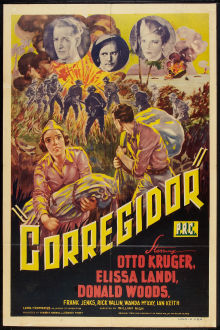Plot
Shortly before the Japanese attack on Pearl Harbor, a doctor, Royce Lee and her maid, Hyacinth arrive at Manoi Island in the Philippines. Royce and her fiancé, Dr. Jan Stockman are married by a local priest, but the ceremony is interrupted by a Japanese attack. In the bombing, Hyacinth is killed. With Japanese invasion forces all around, Royce and Jan join American soldiers making a forced march to Manila, 600 miles away.
The small group is under attack and Jan is wounded. The leader of the American soldiers falls ill with malaria, and commits suicide in order to not hold up the retreating soldiers. Several days later, the group reaches the rocky island of Corregidor, where American forces are holding out in a cavern.
At Corregidor, one of the soldiers, "Pinky" Mason, reunites with nurse Jane "Hey-Dutch" Van Dornen, his girl friend. Royce and Jan work in the army hospital, where Royce realizes her former love, Dr. Michael is also there. With diminishing supplies threatening their survival, the small band of Americans and Filipino defenders face a relentless Japanese attack.
While working as a stretcher bearer, Dutch is wounded. On her death bed, she and Pinky are married but Dutch dies soon after. Jan is also wounded again and dies when the makeshift hospital is bombed. When ammunition runs out, Pinky and the soldiers engage in hand-to-hand combat with the Japanese.
Below ground, in the midst of an air attack, Royce delivers a Filipino baby and then receives news from Michael that her husband has died. Royce and the nurses are ordered to evacuate immediately, she vows to reunite with Michael after the war. Pinky is the tail gunner in the aircraft but dies in a valiant defence of the nurses.
At Corregidor, the lack of supplies forces Michael to operate on the wounded without painkillers or gloves. When the radio operator files his last report, at home in the United States, Royce sheds tears for her lost friends.
This page is based on this
Wikipedia article Text is available under the
CC BY-SA 4.0 license; additional terms may apply.
Images, videos and audio are available under their respective licenses.
